Predicting health crises from early warning signs in patient medical records
- PMID: 36357666
- PMCID: PMC9649019
- DOI: 10.1038/s41598-022-23900-8
Predicting health crises from early warning signs in patient medical records
Abstract
The COVID-19 global pandemic has caused unprecedented worldwide changes in healthcare delivery. While containment and mitigation approaches have been intensified, the progressive increase in the number of cases has overwhelmed health systems globally, highlighting the need for anticipation and prediction to be the basis of an efficient response system. This study demonstrates the role of population health metrics as early warning signs of future health crises. We retrospectively collected data from the emergency department of a large academic hospital in the northeastern United States from 01/01/2019 to 08/07/2021. A total of 377,694 patient records and 303 features were included for analysis. Departing from a multivariate artificial intelligence (AI) model initially developed to predict the risk of high-flow oxygen therapy or mechanical ventilation requirement during the COVID-19 pandemic, a total of 19 original variables and eight engineered features showing to be most predictive of the outcome were selected for further analysis. The temporal trends of the selected variables before and during the pandemic were characterized to determine their potential roles as early warning signs of future health crises. Temporal analysis of the individual variables included in the high-flow oxygen model showed that at a population level, the respiratory rate, temperature, low oxygen saturation, number of diagnoses during the first encounter, heart rate, BMI, age, sex, and neutrophil percentage demonstrated observable and traceable changes eight weeks before the first COVID-19 public health emergency declaration. Additionally, the engineered rule-based features built from the original variables also exhibited a pre-pandemic surge that preceded the first pandemic wave in spring 2020. Our findings suggest that the changes in routine population health metrics may serve as early warnings of future crises. This justifies the development of patient health surveillance systems, that can continuously monitor population health features, and alarm of new approaching public health crises before they become devastating.
© 2022. The Author(s).
Conflict of interest statement
The authors declare no competing interests.
Figures








References
-
- World Health Organization (WHO). Coronavirus (COVID-19) dashboard. In: https://covid19.who.int/. 2020.
-
- Redlener, I., Sachs, J.D., Hansen, S., & Hupert, N. 130,000 – 210,000 Avoidable COVID-19 Deaths – and Counting – in the U.S. New Yor, NY; 2020.
MeSH terms
Substances
LinkOut - more resources
Full Text Sources
Medical

